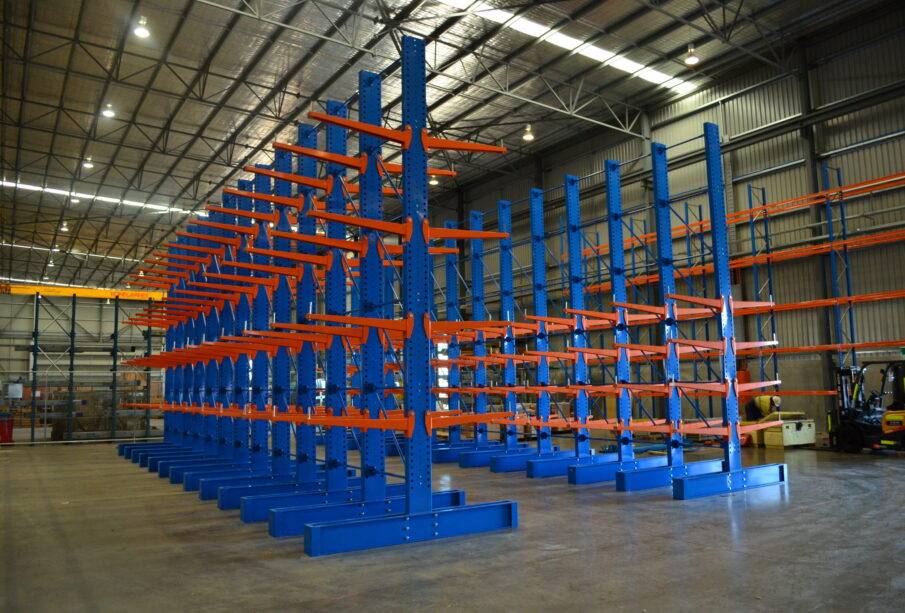Maximising Storage Efficiency with Heavy Duty Industrial Racks

Understanding Heavy Duty Industrial Racks
Heavy duty industrial racks are essential components in warehouses, distribution centres, manufacturing facilities, and various commercial spaces where efficient storage solutions are paramount. These robust shelving systems are designed to withstand heavy loads, maximise floor space, and ensure easy accessibility to stored goods.
Types of Heavy Duty Industrial Racks
Selective Racking:
Selective racking allows for the storage of one-unit-deep pallet loads side-by-side, providing easy access to each pallet without the need to move others.
Drive-in Rack:
Drive-in racks are designed for high-density storage, where pallets are stored in deep lanes and accessed by forklifts driving into the rack structure.
Carton Flow Rack:
Carton flow racks utilise gravity to move cartons or bins along inclined shelves, facilitating efficient picking and restocking operations.
Mobile Rack or Mobile Sliding Rack:
Mobile racks are mounted on powered mobile bases, forming banks of racks that can be operated by a single aisle. These racks are electronically powered and moved to enable access to every aisle when needed.
Advantages of Heavy Duty Industrial Racks
Maximising Floor Space:
Heavy duty industrial racks are designed to free up valuable floor space by vertically storing large, heavy stock items. This vertical storage solution maximises warehouse capacity and allows for efficient use of available space.
Enhanced Durability and Strength:
Constructed from durable materials such as steel, heavy duty industrial racks are built to withstand the rigours of industrial environments and the weight of heavy loads. This ensures longevity and reliability, reducing the need for frequent replacements.
Versatility in Storage Options:
From selective racking to drive-in racks and carton flow racks, heavy duty industrial racks offer versatile storage options to accommodate various types of goods, including raw materials, finished products, and inventory items of different sizes and shapes.
Considerations When Choosing Heavy Duty Industrial Racks
Weight Capacity and Load Requirements:
When selecting heavy duty industrial racks, it’s crucial to consider the weight capacity and load requirements to ensure that the racks can safely support the intended goods without compromising structural integrity.
Space Constraints and Layout Considerations:
The layout of the warehouse or storage facility, as well as space constraints, will influence the choice of heavy duty industrial racks. It’s essential to optimise space utilization and ensure efficient flow of goods within the facility.
Environmental Factors and Specialised Needs:
Factors such as temperature, humidity, and environmental conditions must be taken into account when choosing heavy duty industrial racks, especially for applications such as cold storage or specialised storage requirements.
Materials Used in Heavy Duty Industrial Racks
Metal Shelving:
Metal shelving is the most common material used in heavy duty industrial racks due to its durability, strength, and versatility. Steel shelving systems offer excellent load-bearing capacity and resistance to wear and tear, making them ideal for heavy-duty applications.
Melamine Shelving:
Melamine shelving, made by covering a core material such as particleboard or MDF with a resin that includes melamine, is another option for heavy duty industrial racks. Melamine shelves are strong, durable, and easy to clean, making them suitable for various storage applications.
Applications of Heavy Duty Industrial Racks
Warehousing and Distribution Centres:
Heavy duty industrial racks play a crucial role in warehousing and distribution centres by providing efficient storage solutions for palletised goods, inventory items, and materials handling equipment.
Manufacturing Facilities:
In manufacturing facilities, heavy duty industrial racks are used to store raw materials, work-in-progress inventory, and finished products, ensuring smooth production processes and efficient inventory management.
Retail and Commercial Spaces:
Retailers and commercial businesses utilise heavy duty industrial racks for storing and displaying merchandise, inventory management, and maximising retail space efficiency.
Maintenance and Care Tips for Heavy Duty Industrial Racks
Regular Inspections and Repairs:
Regular inspections of heavy duty industrial racks are essential to identify any signs of wear, damage, or structural issues. Prompt repairs and maintenance help prolong the lifespan of the racks and ensure safe storage conditions.
Proper Loading and Unloading Practices:
Proper loading and unloading practices, including evenly distributing weight across shelves, avoiding overloading, and using appropriate material handling equipment, help prevent damage to the racks and ensure safe handling of goods.
Cleaning and Sanitisation:
Regular cleaning and sanitisation of heavy duty industrial racks help maintain a clean and hygienic storage environment, preventing the accumulation of dust, debris, and contaminants that can compromise product integrity.
Future Trends in Heavy Duty Industrial Racks
Integration of Technology for Smart Storage Solutions:
Advancements in technology, such as RFID tracking, automated inventory management systems, and IoT-enabled sensors, are driving the development of smart storage solutions that enhance efficiency and visibility in heavy duty industrial racks.
Sustainable Materials and Eco-Friendly Designs:
As sustainability becomes a priority in industrial operations, there is a growing trend towards using sustainable materials and eco-friendly designs in heavy duty industrial racks, reducing environmental impact while maintaining durability and functionality.











